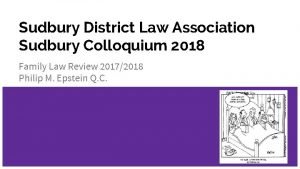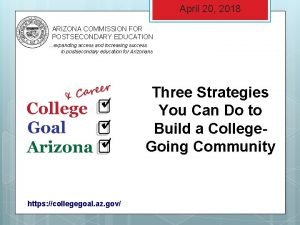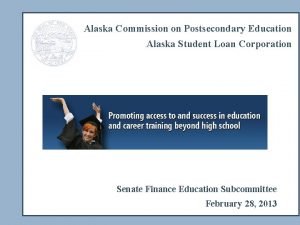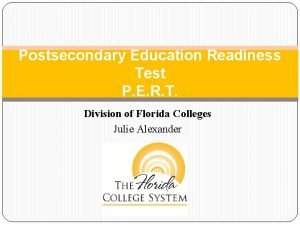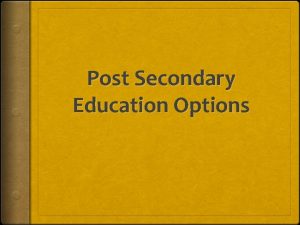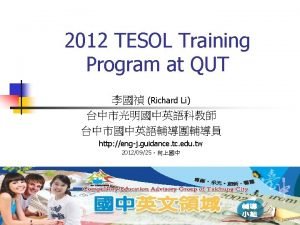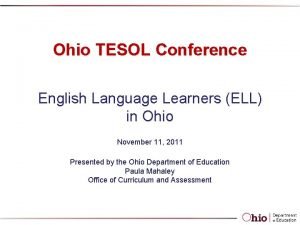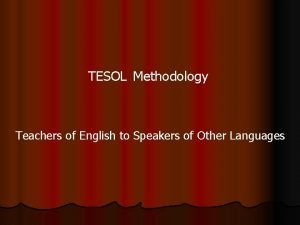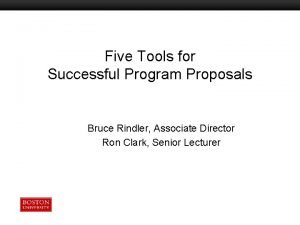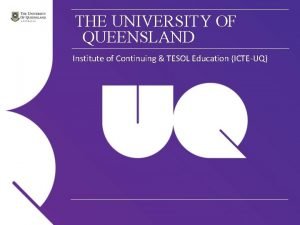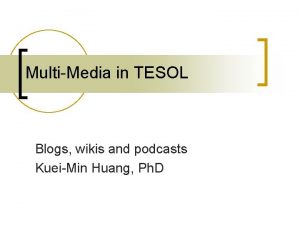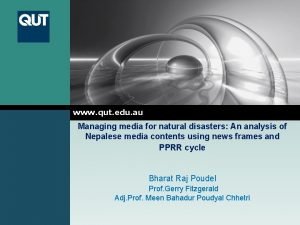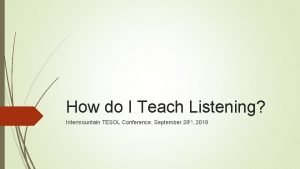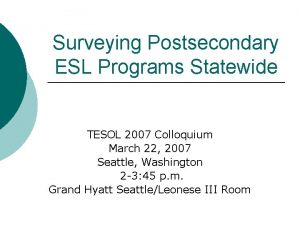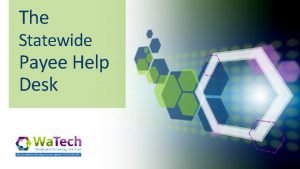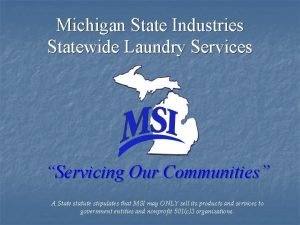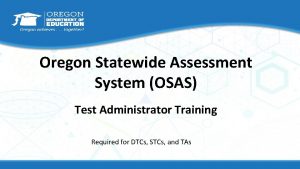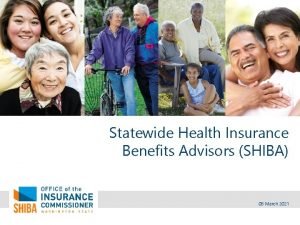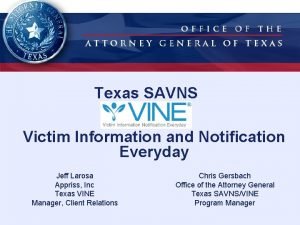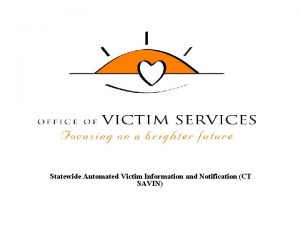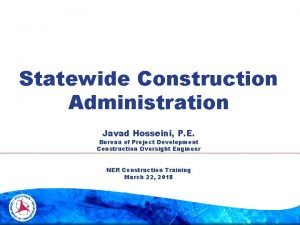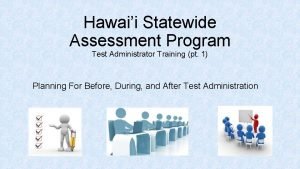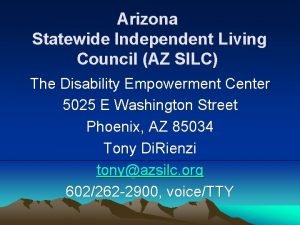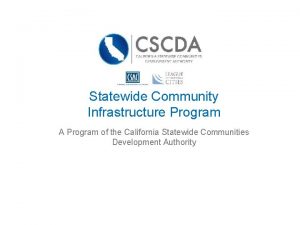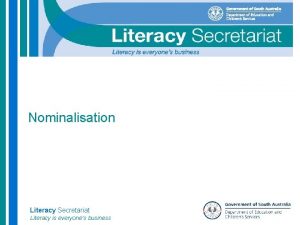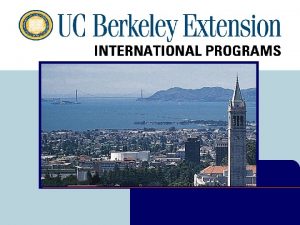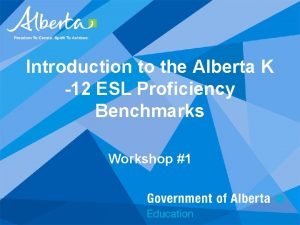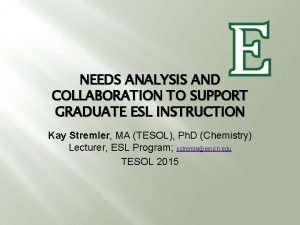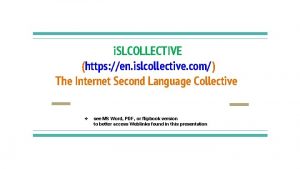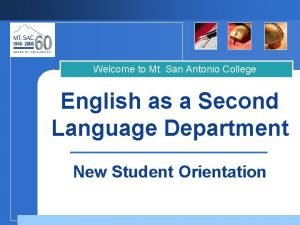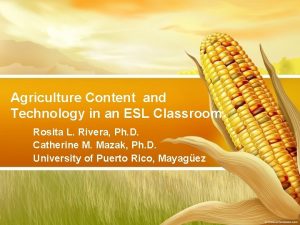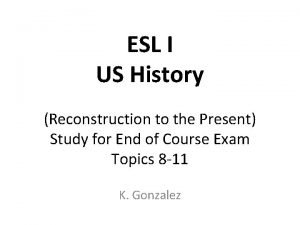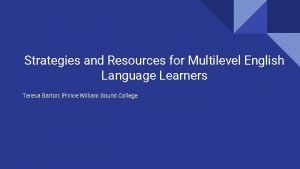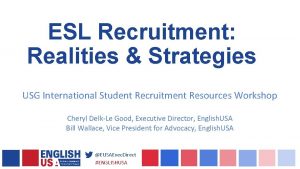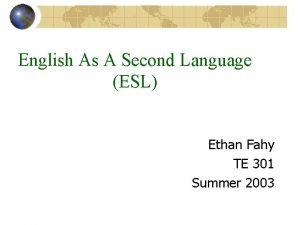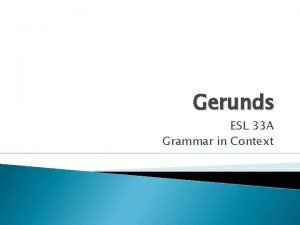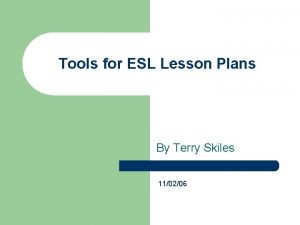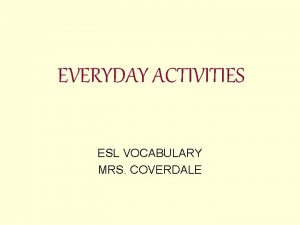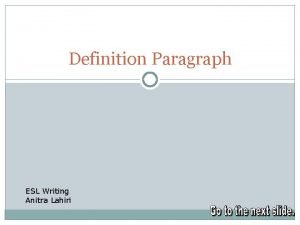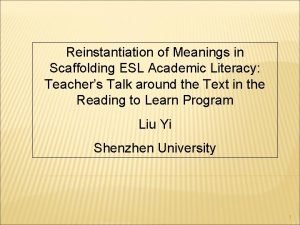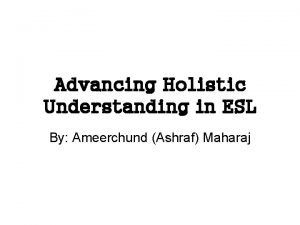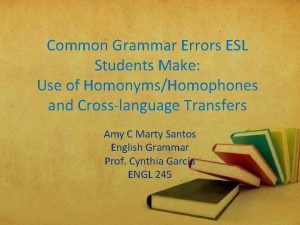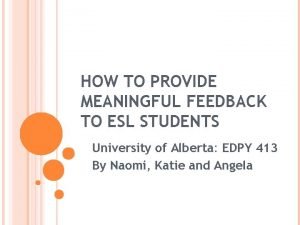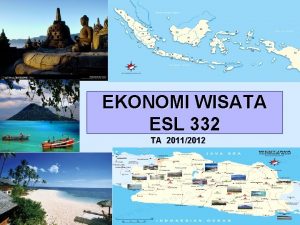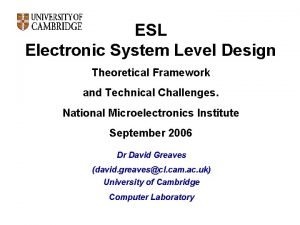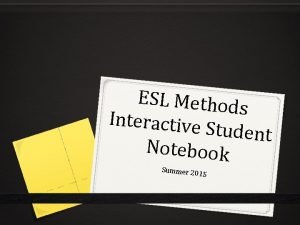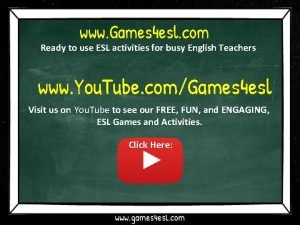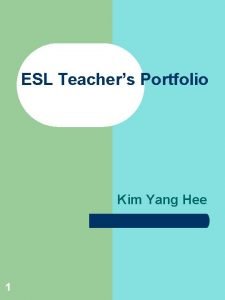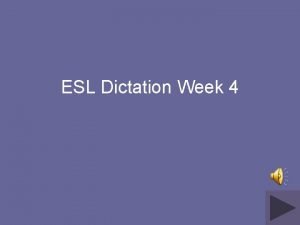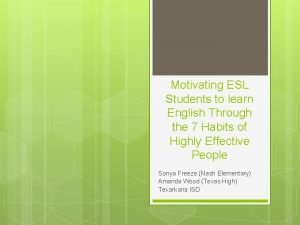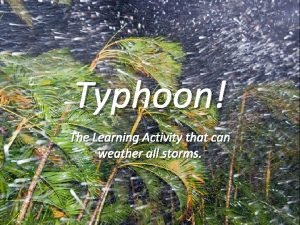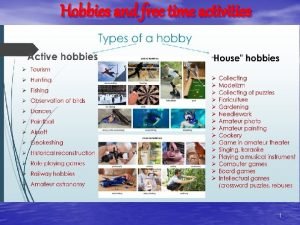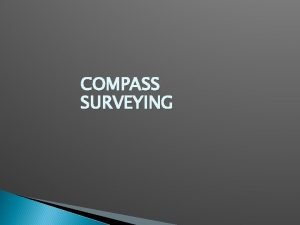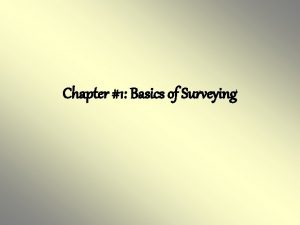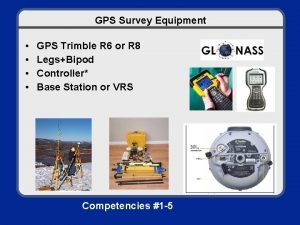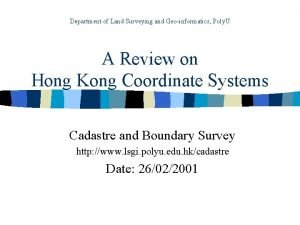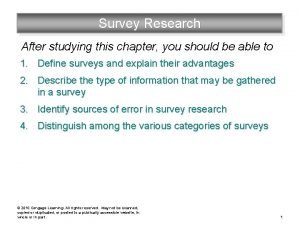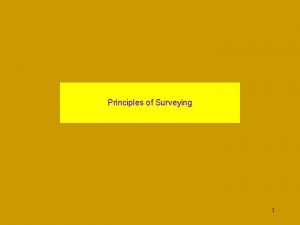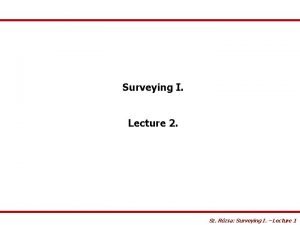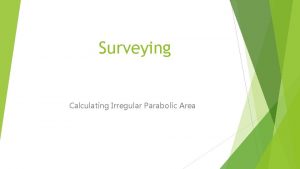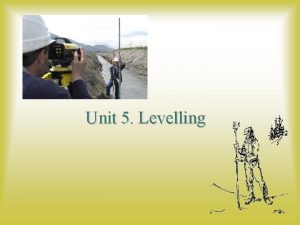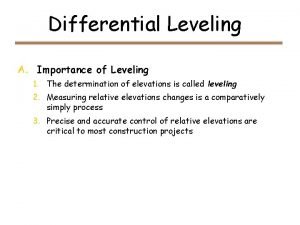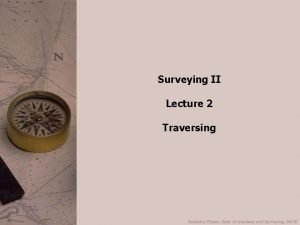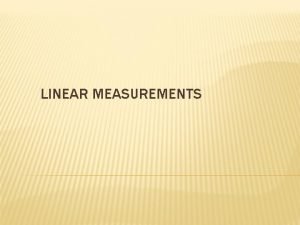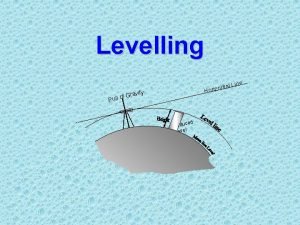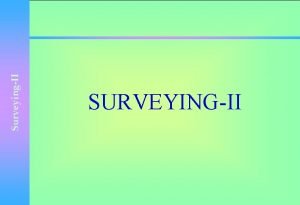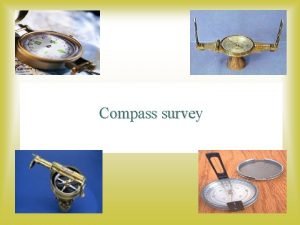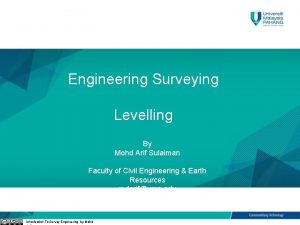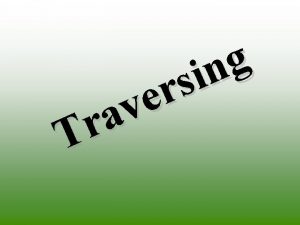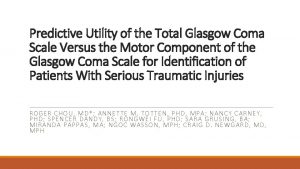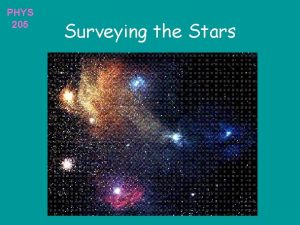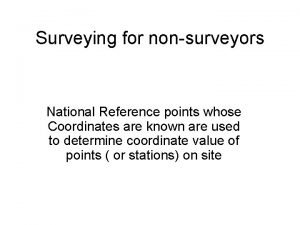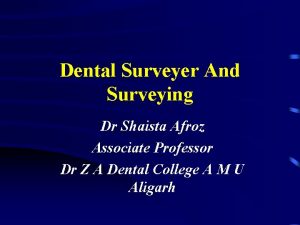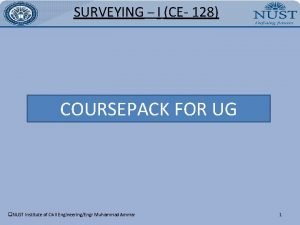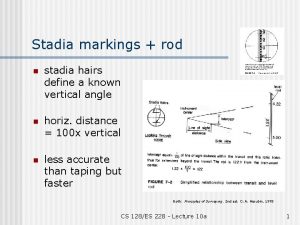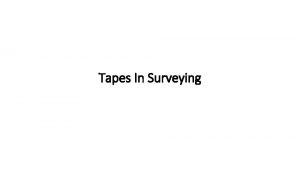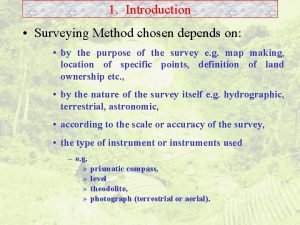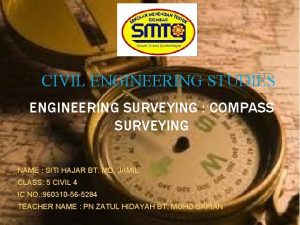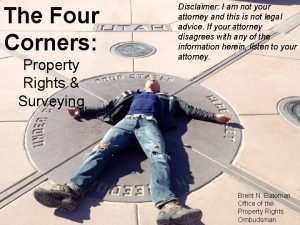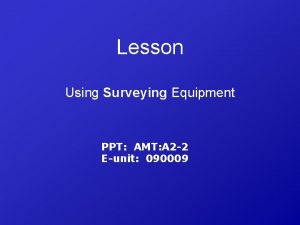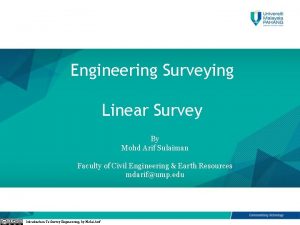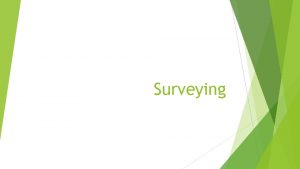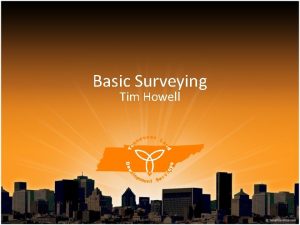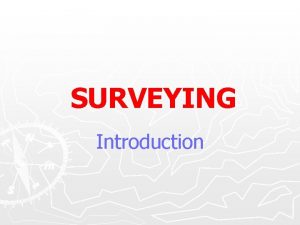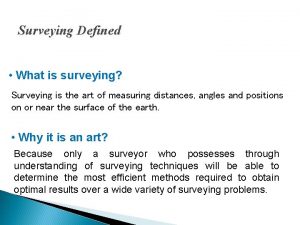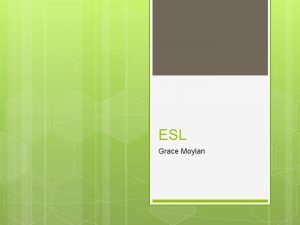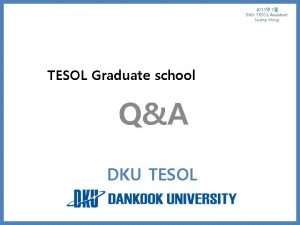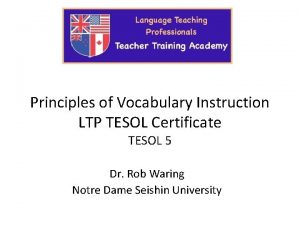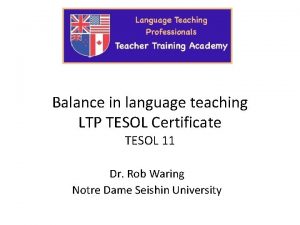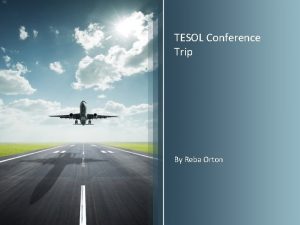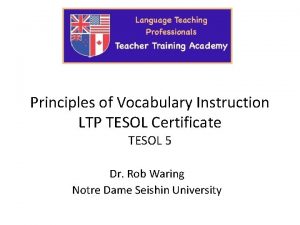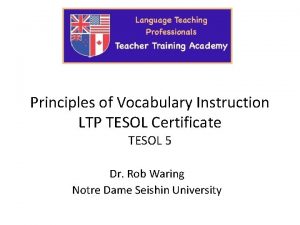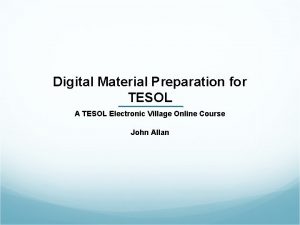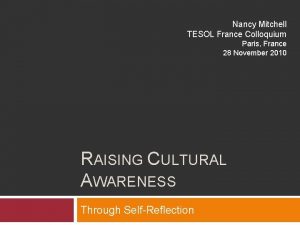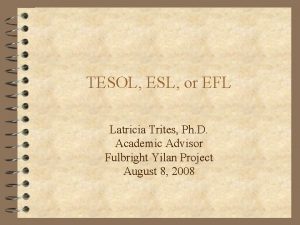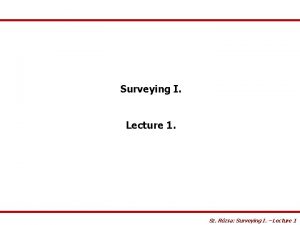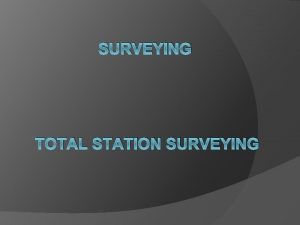Surveying Postsecondary ESL Programs Statewide TESOL 2007 Colloquium















































































































- Slides: 111

Surveying Postsecondary ESL Programs Statewide TESOL 2007 Colloquium March 22, 2007 Seattle, Washington 2 -3: 45 p. m. Grand Hyatt Seattle/Leonese III Room

Presenters Virginia Berger, Grossmont College ¡ Janet Eyring, CSU Fullerton ¡ Jan Frodesen, UC Santa Barbara ¡ Janet Lane, UC Davis ¡ Ellen Lipp, CSU Fresno ¡

Background Information and Need for the Survey (Lane)

Demographic Data ¡ Language minority students comprise 40% of all K-12 students and an increasing population of postsecondary students. (CDE, 2005) ¡ Between 1994 and 2004, the total K-12 enrollment growth rate in California was 7. 8%, but the Limited English Proficient enrollment growth rate was 30%. (CDE, 2005) ¡ Between 2001 and 2005, more than 1 in 5 foreign immigrants to the U. S. settled in California. (Kelley, 2005, LA Times)

Changes in the Population of English Learners ¡ Large increase in number of students who have received most of their education in the U. S. but speak a language other than English at home. l l Many lack competency in college-level academic English and have instructional needs differing from those of native English speakers. Many have been considered English proficient on basis of oral skills from an early age.

Changes in the Population of English Learners (continued) ¡ Colleges must address needs of these students along with needs of two other sub-groups of ESL learners, recently-arrived immigrants and international students. l l Have different needs but are often grouped together in college classes. Often enroll in classes designed for native English speakers; challenge for instructors who don’t have training/materials to work with them. Large and diverse multilingual population with multifaceted educational needs.

The Three California Postsecondary Systems ¡ California Community Colleges (109 colleges) l Any student can enroll; wide range of backgrounds and linguistic proficiencies l ESL has central role in mission (providing ESL instruction considered essential and important function) ¡ California State University (23 campuses) l Main mission to prepare students for workforce and especially teachers for CA schools l Instruction for ESL/multilingual students vary by campus, with some no ESL instruction or services ¡ University of California (10 campuses) l Mission includes research and providing undergrad, and professional education l First developed ESL programs for international grad students (before children of immigrants and refugees reached college age in 1980 s)

ICAS (Intersegmental Committee of Academic Senates) ¡ Established in 1980 ¡ Made up of representatives of the Academic Senates of each segment ¡ Designed to deal with issues of mutual interest, including l Transfer l Articulation l General education l Educational quality and standards

Transfer and Articulation Issues ¡ What are the experiences, needs, and challenges of ESL students as they transition between the three segments? ¡ Is there appropriate articulation of courses with CCC and transfer partners, CSU and UC? ¡ Are English learners progressing successfully within and across the segments? ¡ Do significant differences exist in procedures and offerings across the three segments?

Other Questions Raised by Educators, Administrators, and Legislators ¡ Are colleges effectively distinguishing nonnative English speakers who need specialized instruction from those who do not? ¡ Are assessment and placement procedures for ESL learners adequate? ¡ What programs, courses, and support services are currently offered for ESL learners? Could they be more effective? ¡ How are courses staffed? Are instructors adequately trained to teach them? ¡ What attention is being given to the education of English learners in courses across the disciplines?

Formation of ESL Task Force and Obtaining of Grant

Formation of the ESL Task Force ¡ Initially formed to address the particular concerns of the CCC Board of Governors—concerns shared by a great many others beyond the CCC system. ¡ In December 2003, ICAS (Intersegmental Committee of Academic Senates) appointed four members from each segment (N=12) with the following goals: l To review academic offerings and support services for ESL learners at the California community colleges and four-year institutions l To identify critical issues affecting student success l To make recommendations for improving ESL students’ academic achievement across the segments

Members of the ESL Task Force ¡ California Community Colleges l l ¡ California State University l l ¡ Virginia Berger, Grossmont College Kathleen Flynn, Glendale College John Gamber, American River College Mark Lieu, Ohlone College Jan Eyring, CSU Fullerton Ellen Lipp, CSU Fresno Karen Russikoff, CSU Pomona (Robby Ching, CSU Sacramento) University of California l l Jan Frodesen, UC Santa Barbara (Chair) Janet Lane, UC Davis Robin Scarcella, UC Irvine Jane Stevens, UC San Diego** **Representative from outside the fields of ESL and Applied Linguistics

Obtaining of Grant ¡ Applied for and received a grant, approximately $40, 000, from the CCCs l To perform an online survey and produce a subsequent report l ICAS would be a partner, receiving regular reports as well as evaluating the final report. ¡ The Task Force met regularly and communicated frequently online while working on the project.

Other Related ICAS (Intersegmental Committee of Academic Senates) Projects ¡ California Pathways: The Second Language Student in Public High Schools, Colleges and Universities (1996; revised 2001) l l l Defines ESL proficiency levels that can be used across secondary and postsecondary segments for curriculum development Describes ways second language learners acquire English, the challenges they face, and the very different ESL populations that exist Obtain from CATESOL website: http: //www. catesol. org/pathways. pdf

Other Related ICAS (Intersegmental Committee of Academic Senates) Projects (continued) ¡ Academic Literacy: A Statement of Competencies Expected of Students Entering California’s Public Colleges and Universities (Spring 2002) l l l Responses to questions about the academic preparation of entering freshmen provided by CCC, CSU, and UC faculty through a web-based survey. Report emphasizes need to recognize different subgroups of second language learners and to provide appropriate instruction based on these differences. Obtain from Academic Senate for CCCs website: http: //www. asccc. org/Publications/Papers/Academic. Lit eracy/main. htm

Designing, Piloting, and Revising the Survey (Frodesen) ¡ ¡ ¡ Initial Stages of Survey Design Research Objectives Writing Survey Questions Piloting the Survey Final Revision

Initial Stages of Survey Design ¡ Responding to ICAS concerns as amended by the ESL Scoping Committee (2002) § ICAS Scoping Committee had defined charge of Task Force § Included future Task Force members Lieu, Frodesen, Lane and Lipp

Initial Stages of Survey Design Deciding what is “doable” and “not doable, ” given time/funding constraints § “Doable”: Determining whether or not students are identified as ESL learners; how they are identified; describing types and levels of programs and courses, among others § “Not doable”: Evaluating programs and courses, examining relationships between non-credit/extension programs and a college/ university’s ESL program; examining ESL instruction for Teaching Assistants in 4 -year colleges and universities, among others

Research Objectives 1. To determine if and how students are identified as ESL learners for tracking progress and/or for gathering longitudinal data. 2. To determine how students are identified as ESL learners for the purposes of initial assessment selection and/or for the purposes of appropriate placement. 3. To identify the range of courses and program designs available to address the academic and vocational preparation of ESL learners across the segments, and the processes by which these programs are evaluated.

Research Objectives 4. To identify how the placement of ESL learners into courses specifically designed for ESL learners across the segments is affected by matriculation practices (enforcement of prerequisites, waiver policies, timeline for completion, course repetition). 5. To determine the kinds of student support services that are specifically targeted to ESL learners, whether prior to their enrollment or while they are enrolled in ESL courses, and after they have completed ESL coursework. 6. To determine the types of data on ESL learners that are collected and reported, and the ways in which they are gathered, both while the students are enrolled in ESL courses and after they complete ESL coursework.

Writing Survey Questions ¡ ¡ ¡ Starting with objectives: What we needed to know about ESL learners, programs, services Deciding format of questions (Yes/no, multiple choice, open-ended comments) Committee meetings to draft revise, discuss E-mail listserv: commenting and revision Checking of all questions by members of each segment for missing or incorrect information (e. g. , ways of assessing or placing students

Writing Survey Questions ¡ Consulting with Director of Social Science Survey Center at UCSB ¡ Applied for and received Human Subjects exemption from UCSB Office of Research ¡ Creating separate sections for different segments Examples: Two different sets of questions for Identification of ESL learners (CCC, CSU/UC); three different sets for Assessment and Placement ¡ Multiple drafts produced prior to piloting

Piloting the Survey ¡ ¡ ESL, English, Writing Program faculty contacted from each of the three segments (N=7) Selected based on several variables: college size; type of program (or lack of any ESL program); willingness to assist the Task Force Completed a paper version of the survey (sent and returned by e-mail attachment) Respondents wrote comments, length of time it took to complete, noted any problems

Revising the Survey ¡ ¡ ESLTF responded to pilot survey data (phone, e-mail contacts) Revised for clarity, category confusion (e. g. , writing vs. reading/writing classes) SSSC developed internet version, which ESLTF further revised Resulting survey: 87 questions (Not all questions answered by all respondents)

QUESTION BREAK

Conducting the Survey and Analyzing Results (Lipp)

While the Task Force was writing the survey, the group selected Paolo Gardinali of the Social Science Survey Center (UCSB) to provide the following support: putting the survey on line ¡ making the survey password protected ¡ developing crosstabulation displays of the quantitative data ¡ compiling responses to the openended questions ¡

Trial Run of the On-Line Questionnaire One carefully selected ESL faculty member completed the entire survey and indicated there were no problems.

Identifying Possible Survey Respondents Using personal and professional TESL networks, Task Force members identified a key ESL faculty member on each of the CCC, CSU, and UC campuses; these people were contacted by email and were requested to complete the survey. They were advised the survey would take approximately 30 minutes.

Identifying Possible Survey Respondents (continued) When Task Force members did not know of a key ESL faculty member on a campus, they contacted related departments to request the name of a person qualified to respond to the survey. These people were contacted by email and invited to complete the survey.

Time Line ¡ The first requests to complete the survey were sent out in the spring. ¡ The second requests to complete the survey were sent out during the summer.

The CCC Survey Respondents Of the 109 CCCs, representatives from 61 (56%) completed the survey: ¡ 24 from small colleges ¡ 20 from average-sized colleges ¡ 17 from large colleges

The CSU Survey Respondents Of the 23 CSU campuses, 12 responded: ¡ 2 rural campuses ¡ 5 urban campuses ¡ 5 mixed (difficult to categorize)

The UC Survey Respondents All eight of the UC campuses with ESL programs were asked to complete the survey and all eight of the campuses responded. ¡ There were no ESL programs at UC Merced and at UC San Francisco; those two campuses were not asked to complete the survey. ¡

Our social science research consultant indicated that our response rate was good.

Response Rate Some Task Force members wondered why our response rate wasn’t higher. Was the questionnaire too long? Were there too many open ended questions? Did we have enough resources in our budget to systematically follow up when someone did not respond to the survey?

Reading the Compiled Data Tables (crosstabulations) of the quantitative data. Lists of responses to open-ended questions.

Making Decisions about the Compiled Data To prepare to write up our results, we did the following: ¡ Selected tables that showed important findings. ¡ Combined information from several tables into one to make our findings clearer. ¡ Identified trends in the open-ended response. ¡ Noticed some gaps in the data. ¡

Information on Survey Respondents (Lane)

Survey Questions Designed to Gather Respondent Information ¡ ¡ ¡ What is your job position? How long have you been at this position (please state years/months)? What is your degree/professional preparation (e. g. , B. A. English + TESL Certificate, M. A. English, Ph. D. Applied Linguistics)?

Positions Held by Respondents at Their Institutions ¡ Professors: 21% ¡ Lecturers or instructors: 20% ¡ Joint appointments as professor/instructor and administrator: 33% ¡ Administrative positions (no teaching): 26% ¡ Teaching at least a part of the respondent’s position: 82 % Numbers are approximate.

Additional Respondent Information Respondents’ Length of Time at Job Position l l 5 years or less: 34% 6 to 10 years: 22% 11 – 15 years: 23% 16 or more years: 21% Professional Degrees Held by Respondents l 72% had at least a Master’s degree ¡ ¡ l 38% an M. A. in TESL 8% TESL certificate with M. A. in another field 27% held a Ph. D. degree Numbers are approximate.

Profiles of Individual Colleges and Campuses

Profiles of Individual Campuses l Narrative descriptions of 7 individual colleges/ campuses (500 words or less) l A portrait of the services for ESL and multilingual students at each location l Characteristics and variety of students served l Information on faculty (full-time vs. parttime) l A more holistic illustration of the diversity of programs and learners than provided by discrete categories in survey findings.

Writing the Campus Profiles ¡ Profiles written by members of the Task Force either l l About their own campus or college After obtaining information from a key person familiar with ESL at the college or campus of interest

Campus profiles from the CCC system ¡ Yuba College, Marysville (northern California, rural area) l 5, 500 students; 375 (mostly immigrants/residents) in ESL courses l 3 full-time ESL instructors and 8 adjunct faculty l Majority of students Hispanic (67%) followed by Hmong and East Indian. ¡ American River College, Sacramento (northern California, urban area) l 32, 000 students; 3050 served in ESL (64% immigrants over the age of 30) l 14 full time ESL faculty, 21 adjunct; 10 - 15 instructional assistants and tutors l Majority of students (70%) Russian and Ukranian.

Campus profiles from the CCC system (continued) ¡ Grossmont College, San Diego (southern California, urban area) l 18, 000 students; 1, 000 in ESL program (50% international/50% residents/immigrants) l 4 full-time ESL instructors and 25 adjunct faculty l Immigrants/residents largely Hispanic and Middle Eastern; internationals are largely Asian, with Japanese the largest group. ¡ North Orange School of Continuing Ed (southern California, urban area) Noncredit segment of this CC district; Primary focus of students is survival English, English to help find a job or improve current job status l l l 65, 000 students; 11, 000 served by ESL program (3 campuses) 3 full-time ESL faculty out of 130 total ESL faculty members 75% from Spanish-speaking households; second largest group is Korean

Campus profiles: CSU and UC systems ¡ California State Polytechnic at Pomona (20, 000) Southern California; no ESL program but has parallel track of writing courses in English for Multilingual Speakers Program ¡ California State University Fresno (20, 000) Central California; offers courses and services for ESL and multilingual students through the Linguistics Department ¡ University of California, Davis (30, 000) Northern California; offers courses and services for ESL and multilingual students through Linguistics Department

Campus profiles: CSU and UC systems For all: ¡ Students are combination of recent immigrant, Gen 1. 5, and international ¡ ESL courses also serve as training ground for grad students in TESL/SLA ¡ Separate intensive English for nonmatriculated students may exist

Value of the Campus Profiles ¡ Give a holistic picture of a few representative campuses ¡ Reveal a wide range of course offerings, many different student populations, and significant differences in how programs are staffed and administered ¡ Give readers a sense of the variety of challenges faced by campuses in assessing students and in designing and administering ESL programs and courses

Collaboratively Writing the Report (Berger)

Timeline for Writing Report Oct. 05 Meeting – Planned structure of report; assigned writing teams ¡ Nov. 05 -1 st drafts written and reviewed ¡ Dec. 05 and Jan. 06 – New drafts; additions of appendices, glossary, profiles. ¡ Feb. 06 – Feedback from Exec. Comm. of Academic Senate and ICAS ¡ March 06– Report submitted and executive summary written ¡

Report content and organization Executive Summary ¡ Introduction ¡ The Survey ¡ Survey findings and recommendations ¡ Conclusions and recommendations ¡ References ¡ Glossary ¡ Appendices ¡

Writing teams Teams of three – one from each segment ¡ One section of the survey per team ¡ Team communicated via email and conference calls ¡ Members submitted their sections to team leader for compilation and submission to committee chair ¡

Guidelines for each section Introduce section of survey and explain why these questions were asked ¡ Include tables with exact data ¡ Integrate some representative comments; list others at end for possible inclusion later ¡ Summarize major findings and make recommendations at end ¡

Feedback Process ¡ ¡ ¡ Completed drafts were assigned to different teams as well as to committee chair for comments Used editing feature in Word Drafts presented to Intersegmental and Executive Committees of Academic Senate

Editing Sample ¡ Matriculation processes vary by level and are sometimes stipulated by the Chancellor’s office. Matriculation processes are actually stipulated in Title 5 regulations for the community colleges. Are there matriculation guidelines for CSU and UC Yes, there are UC guidelines , though not specifically for ESL students but for satisfying Subject A/ELWR– situation of ESL S’s varies because some are in ESL classes and some are in mainstream comp from the jump. We can discuss this further at meeting?

Issues or Discussion Points What overall themes can we find from the data? ¡ Should we address each of the survey questions? ¡ How much data and what specific data should be included? ¡ How can we effectively include the comments? ¡

Issues or Discussion Points How should data be presented? ¡ Writing style – more prose or more data? ¡ Who is our audience? ¡ Who needs to approve the report? ¡ Do we need an Executive Summary? Should we have different ones for different audiences? ¡

Lessons Learned Allow enough time and avoid holiday breaks ¡ Get as much feedback as possible ¡ Respect everyone’s opinions; communicate often and in detail ¡ Make the assignments very clear ¡ Have a chair with lots of experience on similar projects who can pull together the final document with great skill. ¡

Disseminating Results (Eyring)

Reports at Official Meetings Progress Report on survey design for CSU TESOL Group Meeting at State CATESOL Conference, 2005 ¡ Presentations at regional and state CATESOL Conferences by members of ICAS Committee, 2006 ¡ Presentation on survey design and results at this TESOL conference, 2007 ¡

Academic Senate Meetings ¡ California Community Colleges ¡ California State University ¡ University of California

Statement by the Intersegmental Committee of Academic Senates (p. 1 of ICAS ESL Task Force Report) “The Intersegmental Committee of Academic Senates joins the authors of the report in the fervent hope that this report will be widely read and shared, and that the issues covered and raised will engender further discussion and action to bring academic success to ESL learners in California’s public colleges and universities. ”

ESL Students in California Public Higher Education: ICAS ESL Task Force Report (Spring 2006) ¡ ¡ CCC Academic Senate website www. asccc. org (Enter “ESL Students” in Publications search slot) ERIC Database http: //www. eric. ed. gov/ ED 493798

QUESTION BREAK

California Survey Results ¡ Identification ESL Learners ¡ ESL and Assessment of Courses and Programs ¡ Student Support Services

Identification and Assessment of ESL Learners (Eyring)

Most Common Means of ESL Identification ¡ CCC – self-identification in a check-box on an application or through a selection of a placement test; this information is combined with results on placement tests ¡ CSU – self-identification when students take the English Placement Test (EPT); only a few campuses make use of selfidentification data ¡ UC – “E” designation for learners who exhibit ESL characteristics on the UC Systemwide Analytical Writing Placement Exam (AWPE); on most UC campuses essays will be reread and student biographical data considered for placement purposes

Progress Tracking of Freshmen ESL Students Progress not tracked Progress completing ESL courses tracked Progress completing other writing requirements tracked CCC CSU UC 38. 3% 41. 7% 12. 5% 56. 7% * 62. 5% 5. 0% * 25. 0% *These questions were not asked of the CSU

Assessment and Placement Issues in the Community College System ¡ Fewer than 40% collect writing samples ¡ Lack of funds for research to validate tests ¡ Students may mistakenly select the wrong test because of no guidance from counselors ¡ Some students may knowingly select the wrong test to avoid ESL stigma ¡ About 25% of campuses do not provide a separate ESL instrument for ESL learners

Challenging ESL Placements and Prerequisites at the Community Colleges ¡ At most community colleges, ESL placements are advisory and can be challenged by meeting with an ESL faculty member, counselor, and/or administrator and possibly taking an additional writing assessment or obtaining a waiver ¡ 82. 5% indicate that students can challenge the prerequisite for a course ¡ No time frame is imposed within which ESL coursework must be completed

Challenging ESL Placements at the CSUs ¡ Only 27. 3% indicate that an additional ESL placement test is employed in the assessment process; sometimes this test is only for international students ¡ At some campuses students are placed into courses by cut scores alone; at others they are evaluated by readers; at others a combination of cut score and self -identification are used to place students in ESL classes

Challenging ESL Placements at the CSUs (continued) ¡ Students have one year to remediate before being redirected to a community college ¡ Student placement into ESL classes varies significantly among the campuses, from 50 to 650 ¡ GE Breadth or IGETC completion may not assure that an ESL student has achieved academic writing proficiency; students continue to manifest significant second language writing problems on the junior level writing proficiency exam (e. g. , GWAR, JEPET, and WPA)

Challenging ESL Placements at the UCs ¡ 62. 5% ESL or Writing Program faculty reread the “E” designated examinations to make placement decisions ¡ Within mainstream composition programs, students may be directed to writing courses specifically targeted to ESL learners ¡ Many “E” designations are for Generation 1. 5 students, who have received most or all of their education in the U. S.

Challenging ESL Placements at the UCs (continued) ¡ ¡ ¡ Some campuses use campusdeveloped assessments in reading, grammar, and listening to place students into ESL classes Campus policies vary regarding challenging ESL placements Only one campus tracks incoming CCC transfers for English language proficiency

Recommendations 1. The California Community Colleges and California State Universities should consider the thoughtful implementation of an ESL-identifier, perhaps similar to the University of California's "E" designation for the purposes of helping to identify ESL learners before classes begin and longitudinal tracking of ESL learner progress in each system.

Recommendations (continued) 2. Effective ESL identification, assessment, and placement procedures at UC and CSU campuses should be summarized so that other campuses can easily learn about them. 3. Each segment should provide a formal organization of ESL Coordinators. We need to meet and discuss identification, assessment and placement issues along with other matters.

Recommendations (continued) 4. To encourage students to take the appropriate assessment exams and courses, school and college administrators, counselors and faculty should consider ways to mitigate the stigma of taking ESL courses 5. Faculty working across all segments should re-examine ESL assessment procedures at the community colleges to provide a better transition for transfer students into the CSU and UC. One way to achieve this may be by reviewing assessment practices at CCCs so that direct assessment with writing samples becomes more common.

ESL Courses and Programs (Lipp)

LIPP ESL courses & Progr - Table 3

LIPP ESL courses & Progr - Table 4

Summary of major findings about ESL courses and programs Range of campuses offering ESL courses ¡ Most CCC and CSU and all of the UC campuses offer courses for ESL learners. ¡ But we did not receive responses on this question from 46% of CSU campuses; these may be the very campuses that do not have courses for ESL learners.

Summary of major findings about ESL courses and programs (continued) Student populations served by ESL courses ¡ At most UC campuses, courses for ESL learners serve freshmen rather than upperdivision students ¡ At CSU campuses these courses serve both freshmen and upper-division students. Credit for ESL courses ¡ Regarding credit, at many CSU and most UC campuses, ESL courses are credit bearing, while at the majority of CCCs, most ESL courses are credit bearing. ¡ But CCCs offer two types of credit-- degree versus workload credit--while CSUs and UCs offer degree credit.

Other Issues ESL course sequencing ¡ A high percentage of campuses from CCC, CSU and UC expect students to complete a specific sequence of courses designed for ESL learners rather than just a single course. Kinds of undergrad classes for ESL learners ¡ Community colleges offer a wide range of ESL courses (e. g. listening, speaking, reading, writing, grammar) while most CSU and UC campuses offer a narrow range of ESL courses, primarily writing or reading/writing or grammar.

Other Issues (continued) Levels of instruction among ESL courses ¡ Community colleges offer the largest range of levels of instruction for ESL learners in ALL skill areas. ¡ Only CCCs offer a range of levels of instruction in all skill areas, including reading, listening, speaking, grammar, and multi-skills. ¡ There are more levels of ESL writing courses at CSUs and UCs and not of other language skill areas. Need for additional ESL courses ¡ The majority of community college and CSU respondents and some UC respondents report that additional ESL courses are needed ¡ Many community colleges report needing additional sections of classes already offered in order to meet ESL learners’ needs. ¡ The need for additional sections of existing classes is less pronounced at CSU and UC campuses.

Recommendations about ESL Courses and Programs ¡ Because not all CCCs, CSUs, and UCs offer special courses for ESL students, each campus should be encouraged to assess whether their students have ESL problems pertaining to use of academic English. ¡ Campuses need to identify multiple ways to help ESL students, including designing ESL programs and courses, hiring instructors trained to teach ESL, offering or improving ESL tutoring, offering mini-courses that address ESL problems, and counseling ESL students. ¡ Second language researchers have emphasized that it takes many years to become proficient in academic uses of English; therefore, ESL classes should be offered both to entering and transfer students.

Recommendations about ESL Courses and Programs ¡ When ESL courses involve mainly academic writing, class size needs to be kept low in order for instructors to give quality feedback to students. ¡ Campuses should investigate the constraints on ESL course repeatability and length of time allowed to meet requirements. ¡ Because of the academic nature of higher level ESL courses, students should be able to earn credit that counts toward their degree when taking these courses.

Student Support Services (Berger) “any of the means by which a school or institution provides direct assistance to students”

Orientation/Initial Advising CCC ¡ no separate sessions ¡ special sessions for international students but not residents ¡ computer orientations designed for ESL learners ¡ bilingual orientation CSUs and UCs ¡ conducted through international student offices

Counseling ¡ CCCs – ¡ CSUs ¡ UCs -2 campuses offer ESL counseling to 60% offer ESL counseling to international students but fewer than half to resident students – over 50% offer ESL counseling to international students; very few to resident students international students, one of which offers it to resident students as well

Services for “at-risk” students ¡ ¡ CSUs – 40% CCCs - 33% UCs - 25% EOP Summer Bridge offers ESL courses through the Learning Skills Center in an accelerated summer program. The program also provides tutoring, orientation, and social activities. In recent years, the majority of students in the program have been Generation 1. 5 long-term immigrants. During the fall, freshmen are placed into ESL learning communities. (CSU)

Tutoring/Learning Centers ¡ All three segments provide tutoring targeted for ESL learners ¡ Problems mentioned- lack of training; insufficient pedagogical and grammatical knowledge; high turnover; insufficient funding

Outreach to Feeder High Schools and Transfer Services ¡ CSUs –Summer Bridge; Step to College programs ; Transfer services- 25% IS; 13% for residents ¡ UCs –Engaging Latino Communities for Education (ENLACE); 1 of 4 campusestransfer services ¡ CCCs- Transfer services -19% for IS; 13% for residents

Other Services ¡ ¡ ¡ Financial Aid, Job Placement/Career Services, Disabled Student Services 14% of CCCs and UCs have special services for disabled ESL students None of the CSUs indicated special ESL services

Recommendations ¡ ¡ 1. Campuses should expand adapt advisement for all groups of ESL learners. 2. Campuses should develop more effective ways to disseminate information about support services to ESL learners, such as online resources, handbooks, and CDs.

Recommendations ¡ ¡ ¡ 3. Campuses should consider a broad range of service delivery methods… 4. Campuses should call on ESL professionals as resources for transfer… 5. Campuses should find or develop assessment instruments to identify learning disabilities among ESL learners….

QUESTIONS

Conclusions (Frodesen) Populations of ESL learners ¡ Urgency of addressing language develop needs ¡ Summary of survey results ¡ Importance of intersegmental collaboration ¡ Need for ongoing communication ¡

Populations of ESL Learners ¡ ¡ ¡ ESL learners on all campus whether officially recognized or not Not always readily identifiable Populations varied with different needs International students Recently arrived immigrants Long-term/American born learners (generation 1. 5)

Urgency of Addressing Language Development Needs Educational success of ESL learners affects not only them but classmates, institutions, society ¡ Number of ESL learners in higher education is increasing ¡ Educational policy decision makers/ administrators need to include ESL learners’ language needs in institutional priorities ¡

Summary of Survey Results Documented Needs: ¡ Improved identification of ESL learners ¡ Better processes for assessment and placement ¡ ESL courses adequate in number, level and breadth ¡ Student services to provide needed support for success of ESL learners

Intersegmental Collaboration TF members gained much from interaction with peers from other segments ¡ Increased understanding of specific problems of particular segments ¡ Gained new awareness of striking differences between segments due in part to different missions ¡

Ongoing Communication Continued communication among ESL educators essential to effective response to ESL learners in higher education ¡ Task Force emphasized need for vehicles for communication and sharing of resources ¡ Need for ESL professionals within each segment to meet ¡

Recommendations Identification, Assessment, Placement ¡ ESL Courses and Programs ¡ Student Support Services ¡ Additional Recommendations ¡

Identification, Assessment, Placement 1. 2. Our public higher education systems should work with legislators toward the goal of developing a statewide system for identifying ESL learners and tracking their progress through the system Campuses should review current assessment and placement instruments, and, where needed, develop more accurate instruments and appropriate placement procedures for ESL students

ESL Courses and Programs 1. Campuses should provide ESL instruction and related support services to entering and transfer students, including generation 1. 5 students. 2. Campuses should review the adequacy of current ESL instruction. Issues examined might include the following: skill areas and number of levels, appropriate class size, the number of course sections, degree applicability of courses, course repeatability, and program evaluation. 3. Campuses should encourage ESL learners to address their academic language needs in an appropriate and timely manner

Student Support Services 1. 2. 3. Campuses should coordinate and improve support services specifically designed to meet ESL learners' needs, keeping in mind the different populations (international students, immigrants both long-term and recently arrived, generation 1. 5). ESL professionals should be called on as resources in all areas of student support for working with ESL students. Campuses should improve the identification of ESL students with learning disabilities and develop ways to meet their special needs.

Additional Recommendations 1. Through intersegmental collaboration, a higher education website should be developed for ESL professionals from all three segments of higher education in California with features such as: • • 2. Directory of CA public C/U college and university professionals Searchable annotated bibliography of studies, program profiles and reports focusing on current ESL practices and issues in higher education + links to reports Each system should institute a formal organization of ESL Coordinators to develop ways to serve ESL students more effectively.

How to Access this Powerpoint Presentation http: //www. esl. ucsb. edu/people/frodesen. html
 Family law sudbury
Family law sudbury Overview of software engineering
Overview of software engineering Arizona commission for postsecondary education
Arizona commission for postsecondary education Alaska student aid portal
Alaska student aid portal Postsecondary education readiness test
Postsecondary education readiness test Postsecondary education options
Postsecondary education options Tesol course qut
Tesol course qut Ohio tesol
Ohio tesol Roughly tuned input
Roughly tuned input Boston university tesol
Boston university tesol Uq eap
Uq eap Tesol wiki
Tesol wiki Www qut edu au
Www qut edu au Intermountain tesol
Intermountain tesol Ucsb extension tesol
Ucsb extension tesol Statewide benefits
Statewide benefits Nova payee services
Nova payee services Statewide laundry
Statewide laundry Osas practice test
Osas practice test Statewide health insurance benefits advisors
Statewide health insurance benefits advisors Savns
Savns Ctsavin
Ctsavin New york statewide senior action council
New york statewide senior action council Statewide construction and development
Statewide construction and development Hawaii statewide assessment program
Hawaii statewide assessment program Arizona statewide independent living council
Arizona statewide independent living council Statewide community infrastructure program
Statewide community infrastructure program Esl scales
Esl scales Jaarindeling esl 2021
Jaarindeling esl 2021 Esl power systems jobs
Esl power systems jobs What is direct method in teaching english
What is direct method in teaching english Gerunds and infinitives jeopardy
Gerunds and infinitives jeopardy Esl jeopardy
Esl jeopardy Berkeley extension esl
Berkeley extension esl Alberta esl benchmarks
Alberta esl benchmarks Esl compound sentences
Esl compound sentences The hamburger paragraph
The hamburger paragraph Needs analysis esl
Needs analysis esl Esl lanternfish
Esl lanternfish Esl collective
Esl collective Mt sac parking permit
Mt sac parking permit Technology for the esl classroom
Technology for the esl classroom Esl american history
Esl american history Jeopardy esl
Jeopardy esl Teaching multilevel esl classes
Teaching multilevel esl classes Esl recruitment
Esl recruitment What is esl?
What is esl? Gerunds esl
Gerunds esl Calla esl
Calla esl Questions about honesty
Questions about honesty Everyday activities vocabulary
Everyday activities vocabulary Anitra lahiri
Anitra lahiri Reinstantiating
Reinstantiating Esl by
Esl by Grammar problems for esl students
Grammar problems for esl students Recast esl
Recast esl Giving feedback to esl students
Giving feedback to esl students Pencetus esl
Pencetus esl Esl design
Esl design Esl interactive notebook
Esl interactive notebook 4esl games
4esl games Esl portfolio example
Esl portfolio example Esl dictation
Esl dictation How to motivate esl students
How to motivate esl students Solar system esl lesson plan
Solar system esl lesson plan Typhoon esl game
Typhoon esl game Free time conversation
Free time conversation Prismatic compass graduated ring
Prismatic compass graduated ring Accuracy ratio surveying
Accuracy ratio surveying Trimble gps survey equipment
Trimble gps survey equipment Types of surveying field notes
Types of surveying field notes Polyu surveying
Polyu surveying Objectives of surveying
Objectives of surveying Balancing of sights mean
Balancing of sights mean What is profile levelling
What is profile levelling Rzsa
Rzsa Trapezoidal rule in surveying
Trapezoidal rule in surveying Rl surveying term
Rl surveying term What is the importance of differential leveling?
What is the importance of differential leveling? Lines traverse
Lines traverse Methods of linear measurements
Methods of linear measurements Rod reading
Rod reading How to calculate hpc in surveying
How to calculate hpc in surveying Theory of probability in surveying
Theory of probability in surveying What is reiteration method in surveying
What is reiteration method in surveying Triangulation surveying
Triangulation surveying Chapter 3 surveying the books of the bible
Chapter 3 surveying the books of the bible If the compass quadrant bearing is n 790 w, the azimuth is?
If the compass quadrant bearing is n 790 w, the azimuth is? Mid ordinate rule
Mid ordinate rule Rise and fall method surveying
Rise and fall method surveying Linear misclosure formula
Linear misclosure formula Scale factor in surveying
Scale factor in surveying Skimming to survey meaning
Skimming to survey meaning Parallax in surveying
Parallax in surveying Contour in surveying
Contour in surveying Partial coordinates surveying
Partial coordinates surveying Apex distance formula in curve
Apex distance formula in curve Linear surveying
Linear surveying Difference between ney and jelenko surveyor
Difference between ney and jelenko surveyor Hypotenusal allowance in surveying
Hypotenusal allowance in surveying Geodetic surveying
Geodetic surveying Rizal and his party went to pagsanjan for what reason?
Rizal and his party went to pagsanjan for what reason? Stadia hairs in surveying
Stadia hairs in surveying Types of tape in surveying
Types of tape in surveying Nominal length of tape
Nominal length of tape Methods of establishing control points in surveying
Methods of establishing control points in surveying Principle of compass surveying
Principle of compass surveying Four corners surveying
Four corners surveying Differentiate between plain scale and diagonal scale
Differentiate between plain scale and diagonal scale Zero circle
Zero circle Chain surveying ppt
Chain surveying ppt Linear surveying
Linear surveying
